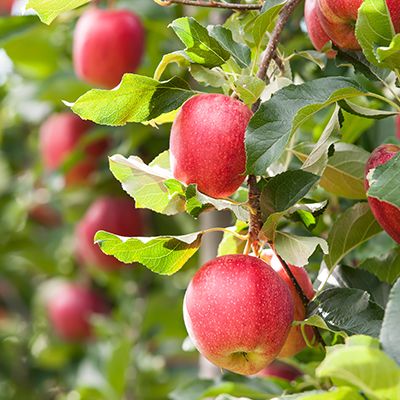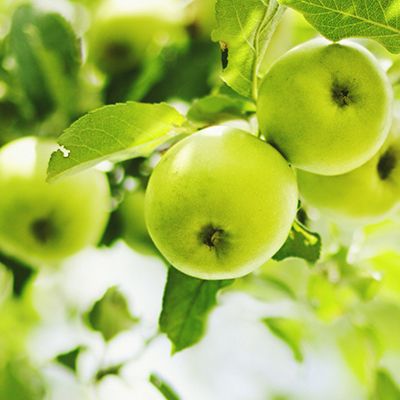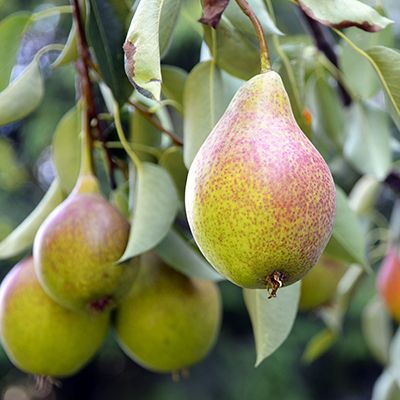Apple and Pear Trees



Prune
When completely dormant in December or January, remove about 20% of current season’s growth. Apple and pear trees produce flowers and fruit on short stubby stems called spurs. The spurs develop on two or more year old lateral branches and will continue to produce flowers and fruit for 10 or more years. They must be preserved when pruning. Competing or crossing branches which interfere with the spurs should be removed. Long water sprout types of current growth should be removed at its origin. To identify fruiting wood, see our Fruit Tree Pruning Care Guide.
Spray
Dormant spray in December or January after pruning with Master Nursery® Pest-Fighter Year-Round Spray Oil at the rate of six tablespoons per gallon of water mixed with Monterey Liqui-Cop® at the rate of two tablespoons per gallon water. Follow label directions for appropriate quantities.
Always check with your nursery professional to properly diagnose problems before undertaking additional sprays.
Codling Moth (wormy fruit)
- Spray: With GardenTech Sevin® (six tablespoons per gallon) when all of flower petals drop. Do not spray trees when in bloom or you kill all the pollenizers (bees). Apply GardenTech Sevin® spray once more, one month after the first spray. Note that GardenTech Sevin® may cause fruit thinning.
- Trapping: In mid-March, to avoid insecticides, set out pheromone traps away from the trunk and about six feet above the ground. Change every two weeks. Use one to two traps for small trees and two to four traps for large trees. This will get about 50% of the moths.
Apple Aphids and Woolly Aphids
- Spray: When insects appear, spray tree, including soil within two feet of trunk, with GardenTech Sevin® or Ortho Malathion Max®. Less toxic sprays include Monterey Take Down Garden Spray or Safer® Brand Insect Killing Soap. Do not spray Ortho Malathion Max® within five days of harvest and GardenTech Sevin® within 28 days.
- Beneficial Insects: Set out ladybugs through the summer. Best when yard has nectar-producing flowers; this would attract adults to stay in the area.
Apple Maggots
These are sometimes found inside apples. The apples will appear rotten and may fall off the tree with several white, one-half inch maggots inside. The codling moth spray (GardenTech Sevin®) schedule should control apple maggots.
Scab (Apple and Pear)
- Scab infections are usually first noticed on leaves. Affected leaves become twisted or puckered and have black, circular scabby spots on their upper surfaces. On the undersurface of leaves, the spots are velvety and may coalesce to cover the whole leaf surface. The fungus survives from one season to the next on twig lesions or in diseased leaves on the ground.
- If you had scab last year, you must treat your plants this year. First, pick up and remove all leaves from the ground. If you have a small tree, also pick all the leaves off the tree and dispose of them. Do not compost. Prune out any twigs or branches with lesions (when you can see them). As soon as all the leaves are off the tree, spray with Monterey Liqui-Cop® at the rate of four tablespoons per gallon of water post harvest before fall rains begin.
- Spray until the tree is dripping and then spray the ground from trunk to drip line. Apply a dormant spray in December/January before leaf buds turn green. At bud break, spray the entire tree to dripping with Monterey Liqui-Cop® at the rate of four tablespoons per gallon of water. Safer® Garden Fungicide can also be applied after bloom, but not within three or four weeks of an oil spray.
Fertilize
Use Master Nursery® Fruit Tree & Vine Food twice a year, around Memorial Day and Labor Day. If you prefer organic fertilizers, use Gardner & Bloome® Citrus & Fruit Tree Fertilizer two to three weeks earlier. After fertilizing immediately water. Apply from one to three feet on both sides of the trunk to the drip line of tree. Supplement organic fertilizers with iron sulfate if plants show chlorosis (shown in the photo at right).
Water
At planting, construct a soil berm at the drip line of the tree. As the tree matures, extend the basin to the span of the drip line. Flood weekly during the first year and then at two to four week intervals when the tree is mature. If a drip system is used, place hosing along the tree’s drip line with emitters on 12 to 16 inch centers. This system will also need to be adjusted as the drip line expands. Both flood and drip irrigation are preferable to sprinklers, since they reduce water splash, a common byway of fungal spores. If sprinklers must be used, adjust heads so that they angle water low and away from the trunk. A large, mature tree may consume 10 or 20 or more gallons of water per week in July and August and September.
Fruit Thinning
When fruit of red apple varieties is three-quarters of an inch in diameter, thin to one fruit every six inches of shoot growth or one fruit per cluster. Yellow and green varieties can be thinned to two fruits per cluster. European pears are typically not thinned. Asian pears, however, are thinned twice: once just after bloom and once 30 to 60 days after bloom. The remaining fruits should be five to seven inches apart on the branch. Note that European pears are harvested green and allowed to ripen at room temperature, and Asian pears ripen on the tree.
Fire Blight
- Fire blight is more common in pears than in apples. Its symptoms are that leaves on the tips of flowering branches blacken, as if scorched by a blowtorch. To control fire blight, prune out all affected tissue about nine inches into healthy wood, sterilizing your pruning tool after each cut with a bleach solution (one part bleach, nine parts water) or Lysol. Then spray with dormant spray..
Spray for fire blight after pruning off diseased parts:
- Apple: One tablespoon Monterey Liqui-Cop® per gallon of water. Start spraying when buds are silvery, but before most buds turn green. Apply weekly until green tip is one-half inch long; then one-two teaspoons per gallon of water at five-seven day intervals when in bloom.
- Pear: One teaspoon Monterey Liqui-Cop® per gallon of water. Spray at five to seven day intervals throughout the bloom period. Start spraying when about 10% of the blossoms are open. Do not spray on Anjou, Comice or Seckel Pears.
Bacterial Blossom Blast
- This disease resembles fire blight but does not progress past the flower clusters on the tree. Cut off and dispose of the dead blossoms. As soon as all the leaves are off the tree, spray with Monterey Liqui-Cop® at the rate of four tablespoons per gallon of water mixed with two tablespoons of Master Nursery® Year-Round Spray Oil post-harvest before fall rains begin.
Sappy Bark
- This disease is occasionally seen on apple trees and then most commonly on Red Delicious or Fuji varieties. The bark dries, shrivels and starts to strip from larger limbs. The limbs crack and leaves die. There is no cure. It is caused by improper pruning.
Bitter Pit (Baldwin Spot)
- This disorder appears to be caused by water stress and/or low calcium in the fruit. Among the most susceptible are Golden Delicious, Fuji and Granny Smith varieties. The fruit will develop dark spots on the skin and the flesh has brown spots one-quarter to one-half inches in diameter. Increase calcium in fall. Fertilize and avoid water stress during summer irrigation.
Sunburn
- Paint trunks and lower branches of young or non-vigorous trees with a one-to-one mixture of white interior latex paint and water to prevent sunburn injury and reduce borer infestations. Apply the paint mixture from two inches below the soil surface and into the lower most scaffold branches.
Adapted from Ogawa and English (1991), Diseases of Temperate Zone Tree Fruit & Nut Crops, UC Extension Publication 3345 and Flint, Pest of the Garden and Small Farm, 2nd Ed., UC Extension Publication 3332.